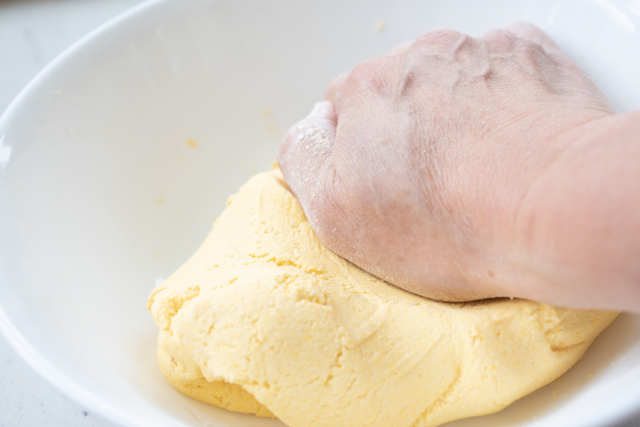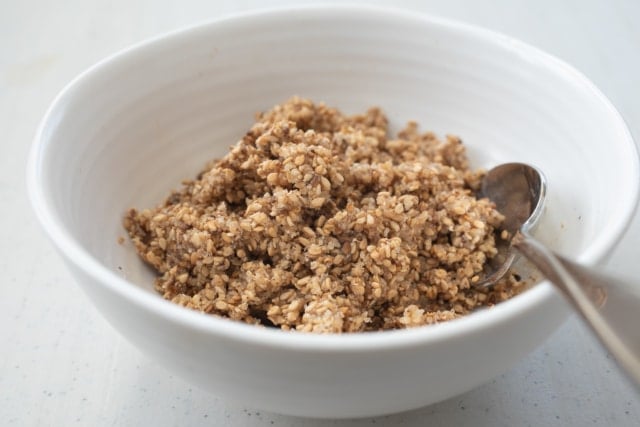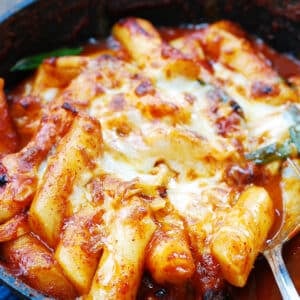Songpyeon is a must-have Chuseok delicacy. These little rice cakes are stuffed with sweet fillings. Learn how to make songpyeon with natural food coloring options!
What is Chuseok
Chuseok (추석) is one of the two most celebrated traditional holidays together with the lunar New Year Day (Seollal, 설날). Also referred to as Hangawi (한가위), it falls on the 15th day of the 8th lunar month – the same day many Asian countries celebrate a Mid-Autumn Festival.
Families gather and celebrate the year’s harvest, giving thanks to their ancestors. Women of the house work hard for days leading up to this day to prepare a sumptuous holiday feast. See my 15 Chuseok recipes. In Korea, Chuseok is celebrated over 3 days.
What is songpyeon
Songpyeon (송편) is a must-have Chuseok delicacy. These small half-moon shaped rice cakes (tteok, 떡) are stuffed with sweet fillings such as sweetened sesame seeds and traditionally steamed on a bed of pine needles. The name songpyeon stems from the use of pine needles, because “song” in “songpyeon” means pine tree.
These little rice cakes are near and dear to my heart, bringing back so many fond memories of this special holiday. A couple of days in advance, we would go to the nearby woods to pick pine needles. Making songpyeon was so much fun!
I remember the excitement I had sitting in front of several colorful huge heaps of dough – as if I was like a child sitting in front of big piles of play dough. But, shaping and stuffing these little guys was also a serious business. There was always a little unannounced competition among us – whose songpyeon looked the best.
My mother used to say I would have a pretty daughter because my songpyeon was pretty. She was right! I developed this recipe, so you can start making these at home, creating a new family tradition and build special memories.
Rice flour for Songpyeon dough
Songpyeon is made with short grain rice flour (쌀가루), NOT glutinous rice (sweet rice) flour (찹쌀가루). Traditionally, Korean home cooks soak short grain rice overnight, drain, and then take to a gristmill to get it ground into fine powder.
While that’s clearly not an option around here, there are bags of frozen wet rice powder for making rice cake (tteok, 떡) sold in the freezer section of Korean grocery stores.
You can try making rice flour at home by soaking short grain rice over night, drain for hours, and then use a powerful blender, coffee grinder, or food processor to finely ground. The rice flour/batter may still come out a bit grainy, not as soft.
How to prepare dry rice for songpyeon:
Many of you told me you don’t have access to wet rice flour, so I’ve experimented with dry rice flour to make songpyeon dough. It’s not the same as wet flour. The resulting rice cakes tend to be a little hard and not nicely soft and chewy. To soften the texture a little, I tried adding some glutinous/sweet rice flour. The result was much better!
Combine 1 cup of dry short grain rice flour (called 쌀가루 or 멥쌀가루), 1/3 cup of glutinous/sweet rice flour (찹쌀가루), and 1/4 teaspoon salt, and mix well. Add 4 tablespoons of cold water, and rub the rice flour between your palms to evenly distribute the moisture. Run it through a medium sieve to sift. Cover with a plastic wrap, and let it sit in the fridge for a few hours up to overnight. This yields about 2 cups of wet rice flour. Follow the recipe below to make songpyeon.
Making songpyeon dough
I use boiling hot water to make the dough, and then knead until the dough is nice and soft. The longer you knead, the chewier the texture of the rice cake will be.
Natural food coloring
Songpyeon dough is typically flavored and colored with natural ingredients such as mugwort, kabocha, and dried fruit powders. This recipe shows how to use mugwort powder and fresh kabocha, I also played around with different natural food coloring and came up with a couple of other colors. You can choose any number of options I’ve given here, or use your own food coloring options. Also see my Beet songpyeon recipe for vibrant red color.
Songpyeon filling
The most common filling is made with sweetened sesame seeds. Black soybeans and mung beans are also traditional. This recipe shows how to make it with sesame seeds.
How to shape songpyeon
1. Tear off a small piece of the dough enough to make roughly 1 to 1.5-inch ball. Roll tightly between your palms to shape a ball.
2. Make a well in the ball by pressing into it with your thumb, and press outwards, with both of your thumbs, on the inside walls of the well to slightly expand the opening.
3. Place 1/2 to 1 teaspoon of the filling in the well.
4. Seal tightly by squeezing the edges together.
5. Squeeze the whole rice cake lightly in your palm to firm it up.
6. Gently roll between your palms to smooth out the surface.
7. Shape it into a nice crescent shape by pinching the long ends with your thumb and index finger.
8. Pinch along the side to create a wing.
Watch how to make it
More Chuseok holiday recipes
Modeumjeon (Fish, Shrimp and Zucchini Pan-fried in Egg Batter)
Galbijjim (Braised Short Ribs)
Japchae (Stir-Fried Starch Noodles with Vegetables)
Nokdujeon (Savory Mung Bean Pancakes)
Sanjeok (Skewered Rice Cake with Beef and Vegetables)
Radish Soup (Mu Guk/Moo Guk)
15 Chuseok Recipes for more
For more Korean cooking inspirations, follow along on YouTube, Pinterest, Twitter, Facebook, and Instagram.

Equipment
- Steamer
Ingredients
Rice Powder (ssalgaru)
- 2 cups wet rice powder per batch (about 16 songpyeon) 쌀가루 or 쌀떡가루 - a 2 pound-bag yields a little more than 6 cups (3 batches) - see note
- 4 to 5 ounces pine needles rinsed 2 – 3 times and air or pat dry (optional)
- 1 teaspoon sesame oil
Natural color option (pick any for each batch):
Basic (white dough)
- 2 cups wet rice powder thawed to room temperature if frozen
- 4 tablespoons boiling hot water more as needed, in 1 teaspoon increments
Green dough
- 2 cups frozen rice powder thawed to room temperature if frozen
- 1.5 to 2 tablespoons mugwort (ssuk garu, 쑥가루) or matcha/green tea powder
- 5 to 6 tablespoons boiling hot water more as needed, in teaspoon increments
Yellow dough
- 2 cups frozen rice powder thawed to room temperature if frozen
- ⅓ cup cooked steaming hot kabocha, (danhobak, 단호박) 1/4 small kabocha steamed in microwave for about 5 minutes
- 1 tablespoon plus 1 or 2 teaspoons boiling hot water
Purple dough
- 2 cups frozen rice powder thawed to room temperature if frozen
- 4 tablespoons plus 1 or 2 teaspoons boiling hot blueberry juice 1/2 cup fresh or frozen blueberries finely pureed with 1/2 cup water, strained and boiled
Pink dough
- 2 cups frozen rice powder thawed to room temperature if frozen
- 4 tablespoons raspberry juice 1/2 cup fresh or frozen raspberries finely pureed with 1/2 cup water, strained, and boiled
Filling: fills about 16 (one batch)
- ⅓ cup roasted sesame seeds
- 1.5 tablespoons sugar
- 1 tablespoon honey
- pinch salt
Instructions
Dough:
- For each type of dough, sift the rice powder into a bowl. Prepare the flavoring and liquid ingredients (water/juice/mugwort powder/kabocha) for each selected color of dough. Add the specified amount of the solid and/or liquid (making sure it’s boiling hot) to the rice powder, quickly stirring them in with a spoon. (Tip: Hold a teaspoon or two of the liquid and make sure more liquid is needed before adding it.)
- Knead, pressing and stretching with the heel of the hand. Fold and rotate the dough. Repeat the kneading process for 4 to 5 minutes. (If the dough sticks to your hands or the bowl after some kneading, it’s too wet. Add more rice powder in 1 tablespoon increments. If the dough breaks easily or is too stiff, it’s too dry. Add more boiling hot water in 1 teaspoon increments.)
- Cover the dough with plastic wrap or a damp towel. Let it rest for 20 to 30 minutes.
Filling:
- Roughly grind the sesame seeds in a grinder or blender. Add the sugar, honey and pinch of salt. Mix everything well together until the sugar and honey are evenly distributed.
Assemble:
- To assemble, tear off a small piece of the dough enough to make roughly 1-inch ball. Roll tightly between your palms to shape a ball.
- Make a well in the ball by pressing into it with your thumb, and press outwards, with both of your thumbs, on the inside walls of the well to slightly expand the opening.
- Place 1/2 teaspoon of the filling in the well. Seal tightly by squeezing the edges together. Squeeze the whole rice cake lightly in your palm to firm it up, and then gently roll between your palms to smooth out the surface. Shape it into a nice crescent shape. Pinch along to create a wing. Repeat until all the dough/filling is used.
Steam and finish:
- Boil water in a steamer. Place a thin layer of pine needles or a silicon liner or damp kitchen cloth in the steamer insert. Boil the water over high heat. When it starts to steam, place the rice cakes in the steamer insert without the pieces touching one another. Cover with a thin layer of pine needles, if available. Cover and steam for about 20 minutes.
- Prepare a big bowl of cold water. Using a long-handed spoon or tong, remove the rice cakes from the steamer. Drop them in the cold water for a quick rinse, removing all the pine needles if used. Transfer the rice cakes to a colander to drain. Lightly coat your hands with the sesame oil and rub the oil on the rice cakes in batches. Serve warm or at room temperature
Notes
How to prepare dry rice for Korean rice cake
Combine 1 cup of dry short grain rice flour (called 쌀가루 or 멥쌀가루), 1/3 cup of glutinous/sweet rice flour (찹쌀가루), and 1/4 teaspoon salt, and mix well. Add 4 tablespoons of cold water, and rub the rice flour between your palms to evenly distribute the moisture. Run it through a medium sieve to sift. Cover with a plastic wrap and let it sit in the fridge for a few hours up to overnight. This yields about 2 cups of wet rice flour. Follow the recipe to make songpyeon.This recipe was originally posted in September 2012. I’ve updated it here with new photos, created a recipe card with minor changes to the recipe.




































